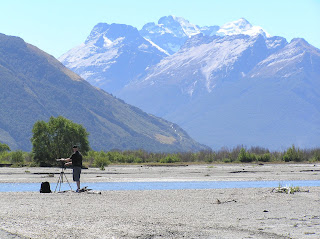 Photo: Jockey Underwear
Photo: Jockey Underwear
Sorry for the long absence! Today I'm happy to say we have a special guest post from Maggie Ewles, who runs an informational website about swimwear and lingerie - two great things to take camping! You can visit her site at: www.swimwearandlingerie.com. Her post reinforces a lot of the advice in "Sex in a Tent", so it's nice to see more of us outdoorsy girls thinking along the same lines!When hitting the great outdoors with your loved one for a little rest and relaxation, the authentic outdoors person will have a tried and true list of camping essentials. Topping the list will be all the survival basics such as a tent, hiking gear, cooking paraphernalia,
knife, flashlights and bug spray. However, what if you were planning on surprising your partner with a little loving in the evenings? Nature lovers will shout out that true backwoods types don’t need props or foolish luxuries to get jiggy in the tent. However, I have found that a few tiny, pre-planned items included in your backpack can pack a heck of a wallop!
First things first…. We all know that bathing in the great outdoors isn’t always a sure thing. We also know that canoodling tends to involve the parts of our bodies that begin to smell rank right off the bat. You may be swimming every day, but quite frankly the things you have planned require a little more attention than a splash around four hours ago can provide. What’s a girl to do? Voila, to the rescue: baby wipes! Seriously, these little wonders offer more cleaning power and durability than your standard wet wipe napkin and they not only clean and freshen, your nether-belows, they also make pretty good kindling once they have dried out. Multifunctional and nice smelling things definitely deserve a little room in the pack, just be sure to pack them in a reseal-able bag or container.
How about your undies? Are you wearing the standard non-cotton (so they will dry overnight and not stay full of congealed sweat for the whole trip) underwear? Camping undies have come a long way in recent years. Backpackers can choose from a ridiculous amount of
colors,
patterns and
styles and even find some that will
double as swimwear which leaves more room in the bag for…yup a little lingerie.
We all love the look and feel of silk but let’s face it, silk really doesn’t pack or travel well. You want your fellow hiker staring in stunned awe at your curves and not your crinkly wrinkly whatever-that-thing-is hanging off your shoulders. So maybe now is the time to break out a little
mesh slip or
teddy that is completely inappropriate for the great outdoors. Seriously, the surprise factor here and the idea that you have planned this will be more than enough fuel to get your buddy fired up.
Next up, we have some important considerations for your body. If you are the type to shave/wax/depilate, consider changing the design of your bikini area. Like a gift being unwrapped, each layer provides a new surprise and thrill. If you are not the de-furring type, pat yourself on the back for not having to waste a good chunk of your life worrying about this crap.
Along with keeping your body clean and potentially less hairy, having visible chafe marks or grooves left from your standard daily
underwear is pretty high on the not sexy list. Nothing like a massive welt running up each side of your hip to scream out; “I was wearing ill-fitting granny pants that reached up to my rib cage the whole day.” A likely mood killer, so, why not shop with an educated eye for a good fit and long term comfort when you are grabbing your camping gear?
Now is not the time to be overly
eco-concerned. Bamboo and cotton are replenish-able resources, however, in a high humidity and sweat inducing environment, these are not the best choices. You could either bring a pair of cotton undies for each day of your trek with a few extras for those just-in-case scenarios, or you could bring two pairs of
nylon/spandex or
wool underwear and simply give them a good wash each evening and allow them to dry overnight, poof, so much more room in your pack for all of the little extras right? But don’t just grab the first pair of nylon briefs you see. Take a look at your body and decide what style is the most flattering; brief, bikini, thong or boyshort? Thank goodness the
Tilley high-waist travel panties aren’t the only option any more. Once you have the style down, make sure they have no-chafe flat seams, are wedgie proof through all motions and are truly moisture wicking. If you are feeling fancy, by all means invest in some of the cooler high-tech options such as the inclusion of
silver ions in the fibers for their anti bacterial/microbial action, sun blocking fabrics or the new no seam styles.
Now that we have your day to day stuff worked out and guaranteed not to leave unsightly wear and tear marks on your body, let’s talk about lingerie. A matching set definitely has a wow factor, but only if there is light in the tent. In which case, you will also be putting on quite the puppet show for all the forest animals and any intrusive camping neighbors. How about texture? Will you bring along something that is satiny smooth or heavily embroidered? Little ribbons and bows are really cute…until they get caught on the zipper of your sleeping bag and you end up needing to be cut free from the metal teeth. The lesson here is don’t bring something you don’t mind losing or destroying. Think of the shock and awe philosophy; after all you aren’t looking to get some real wear and tear out of it, just stimulate some interesting conversation.
We can move on to the third consideration; scarves. Lovely, long, silk or organza scarves can be used in so many different ways. Like… to hang up your every-day undies while they dry, restrain and immobilize an over extended… ankle that you sprained while distractedly daydreaming during your hike or even to tie up… a pulsating wound in a tourniquet when someone overestimates their lumberjack abilities. See? Scarves can be justified for a multitude of uses while also being exceptionally light and easy to pack and quite frankly an excellent source of entertainment, limited only by your imagination.
Whatever you decide to pack in your bag, just remember that confidence is truly the most titillating part of any lingerie set. Now stand tall and show off those sequins, just remember that Park Rangers seldom have a sense of humor so don’t try to pull any streaking Yeti jokes.
Maggie Ewles is the type of person will forgo that extra emergency food ration in order to pack a sexy little
camisole set. She is an avid hiker and believes that women have sacrificed comfort for style for far too long. There is no good reason that stylish
swimwear can’t look good and be wearable at the same time.
 I don't get a lot of corporate Christmas gifts at my day job, but I've seen enough of them to know that the best ones are usually edible/drinkable gifts, and the rest tend to be crappy knicknacks that you either throw away or leave on a shelf for a few years and then...throw away.
I don't get a lot of corporate Christmas gifts at my day job, but I've seen enough of them to know that the best ones are usually edible/drinkable gifts, and the rest tend to be crappy knicknacks that you either throw away or leave on a shelf for a few years and then...throw away.









































